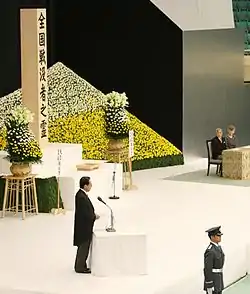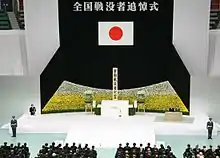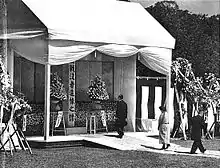National Memorial Service for War Dead
The National Memorial Service for War Dead (全国戦没者追悼式, Zenkoku Senbotsusha Tsuitōshiki') is an official, secular ceremony conducted annually on August 15, by the Japanese government at the Nippon Budokan in Tokyo, Japan. The ceremony is held to commemorate the victims of World War II. The first memorial ceremony was held on May 2, 1952.
| National Memorial War Service for War Dead | |
|---|---|
 The Japanese Prime Minister addressing the attendees on August 15, 2008. | |
| Official name | 全国戦没者追悼式 |
| Observed by | Japanese |
| Type | National observance |
| Significance | A memorial service for military and civilian deaths during WW2, observed on the same day the Japanese Emperor, addressed the Japanese people, to announce the unconditional surrender of the Japanese forces. |
| Observances | Memorial service aired by the national broadcaster NHK |
| Date | August 15 |
| Next time | 15 August 2021 |
| Related to | National Liberation Day of Korea, Victory over Japan Day |

Shūsen-kinenbi
Shūsen-kinenbi (Japanese: 終戦記念日, lit. "end-of-war memorial day") or Haisen-kinennbi (Japanese: 敗戦記念日, "surrender memorial day")[1] also written as shūsen-no-hi (Japanese: 終戦の日) or haisen-no-hi (Japanese: 敗戦の日)[2][1] is an informal reference used by the public, for August 15 and related to the historical events that culminated with the ending of World War II, and the restoration of Japanese political independence.
Those events were:
- August 14, 1945, the day the Imperial Japanese government gave notice to the Allies of World War II accepting the conditions of the Potsdam Declaration,
- August 15, 1945, the day of the Jewel Voice Broadcast announcing to the people of Japan that the Imperial government had accepted the Potsdam Declaration, and unconditional surrender of the armed forces,
- September 2, 1945, the official signing of the Japanese Instrument of Surrender aboard the USS Missouri.[3]
- April 28, 1952, the San Francisco peace treaty with Japan came into force which under international law ended the state war with the Allied nations, and returned independence to Japan,
It is not an official holiday under Japanese law.
Overview
By decision of the Japanese Cabinet, on May 2, 1952 the Emperor and Empress of Japan held a memorial service for war dead in Shinjuku Gyoen. The next such service was held on March 28, 1959. In 1963 the date was moved to August 15, the day the Jewel Voice Broadcast (玉音放送, Gyokuon-hōsō) had aired in 1945.

In the following year the service was held at Yasukuni Shrine, and in 1965 it was moved to the Budokan where it is still held today. In 1982 the Diet enacted a law fixing the date of the ceremony at August 15. The service is meant to honor both Japanese military casualties and civilian victims of war, over 30 million deceased individuals in total.
The event is organized by the Ministry of Health, Labour, and Welfare. The Emperor and Empress are always in attendance, as well as representatives of business, labor, political, and religious organisations, and bereaved families. Roughly 6,000 attendees were recorded in 2007.
The service is scheduled at 11:51am for one hour, and is broadcast by the Japan Broadcasting Corporation.
No invited leader has ever absented himself from the memorial, including those who have criticized visits to Yasukuni Shrine. There has never been a protest from foreign powers about the memorial.
Order of service
- Opening
- Entrance of Their Majesties the Emperor and Empress of Japan
- Anthem: Kimigayo
- Address by Prime Minister of Japan
- Moment of Silence (usually at noon)
- Address by His Majesty the Emperor
- Addresses by Speaker of the House of Representatives, Speaker of House of Councillors, Representative for the Bereaved
- Exit of Their Majesties the Emperor and Empress of Japan
- Offering of Flowers
- Closing
Notable events
- 1988: The Showa Emperor Hirohito, on his deathbed, is flown to the ceremony by helicopter.
- 2006: During Yōhei Kōno's speech, an exceptionally clear reference was made to war responsibility.
- 2007: Last ceremony with a surviving parent of a war victim in attendance.
- 2009: Due to an irregular dissolution of the Diet, there was no Speaker of the House of Representatives.
- 2011: The moment of silence was accidentally delayed by 26 seconds due to a long speech.
References
- "62回目の敗戦記念日に思う". 八重山毎日新聞社 / The Yaeyama-Mainichi Newspapers (in Japanese). Retrieved 2020-08-15.
- author. "「敗戦の日」を覚えて". 日本キリスト教協議会 / National Christian Council in Japan (in Japanese). Retrieved 2020-08-15.
- 平和への誓い新た 69回目終戦の日、6000人参列 全国戦没者追悼式 [Renewed vow of peace. The sixty-ninth memorial day for the end of the war. 6000 attend nationwide memorial for those who died in battle] (in Japanese). Nihon Keizai Shimbun. August 15, 2014. Retrieved August 18, 2014.